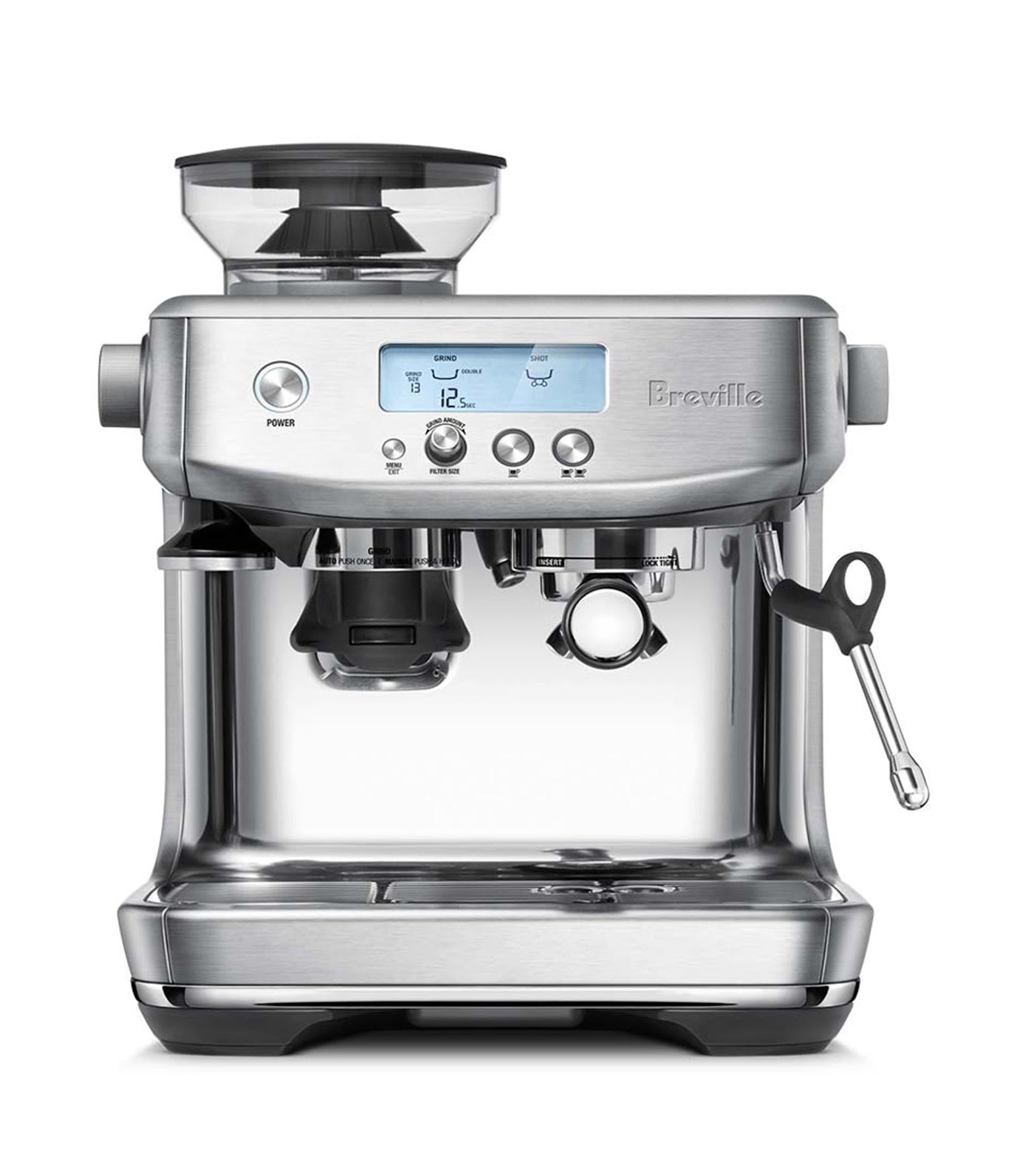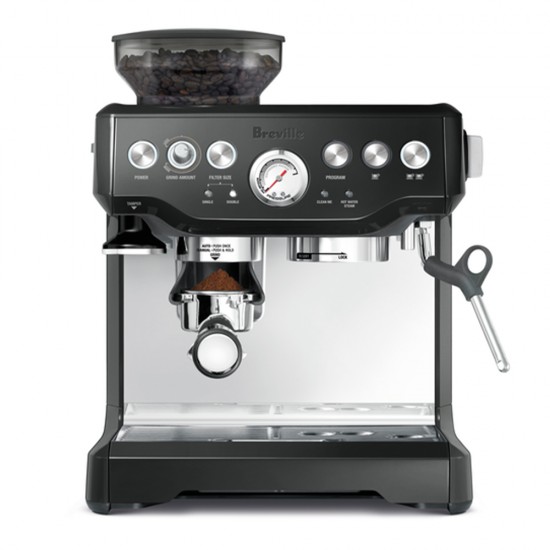#1: Breville Barista Pro

- Fast heat-up time
- Intuitive LCD display for easy operation
- Precise espresso extraction with built-in grinder
#2: Breville Barista Express

- Built-in grinder for fresh coffee
- Affordable for its features
- Solid and durable build quality
As a coffee enthusiast, I've had the pleasure of using both the Breville Barista Pro and the Breville Barista Express. While both machines offer a solid entry into home espresso making, the Barista Pro stands out with its advanced features and user-friendly design.
Barista Pro

Barista Express

Design and Build Quality: Breville Barista Pro vs Barista Express
When it comes to design, the Breville Barista Pro immediately feels more modern. The Pro's slick, angular design paired with its stylish color options—like my personal favorite, Damson Blue—adds a touch of elegance to the kitchen. The more minimalist and curved design of the Barista Pro definitely elevates the countertop aesthetic. In comparison, the Breville Barista Express has a more classic look, which isn't a bad thing, but it's certainly a bit more old-school.
In terms of build quality, both machines are sturdy and well-built. The stainless-steel housing gives both machines a premium feel that you won't get with cheaper espresso makers. However, I personally enjoy how the Pro integrates a more refined finish, which is more resistant to fingerprints.
Heating System and Performance
This is where the Barista Pro really sets itself apart. With the ThermoJet heating system, the machine reaches the perfect brewing temperature in just 3 seconds. That's right, 3 seconds! As someone who's often in a rush in the morning, this feature is a huge timesaver. I can wake up, turn on the machine, and be ready to brew almost instantly. In comparison, the Barista Express takes around 30 seconds to heat up. Now, this isn't a dealbreaker—30 seconds is still pretty fast—but once you get used to the Pro's speed, it feels like an eternity waiting for the Express to heat up.
I also noticed that the Pro maintains a more consistent temperature during the extraction process. The precise temperature control means I get more predictable results from shot to shot, which is especially great if you like to experiment with different beans or roasts.
User Interface and Controls: Breville Barista Pro vs Barista Express
When I first got my hands on the Barista Pro, I was immediately impressed with the intuitive digital interface. The bright LCD screen displays all the information I need, including grind time, extraction progress, and more. For someone who likes a bit of precision, it's really helpful to see exactly what's happening at every stage.
The Barista Express, on the other hand, sticks to a more traditional analog approach. While I do appreciate the tactile feel of the knobs and buttons, it can be a bit more challenging to get everything just right. For beginners, the analog controls may be a little daunting, and it's easier to make mistakes. The digital display of the Barista Pro just makes the whole experience more approachable, even if you're new to espresso machines.
Grinder and Grind Settings
Both machines come with integrated conical burr grinders—a fantastic feature that saves you from buying a separate grinder. However, the Barista Pro offers 30 grind settings compared to the 18 settings of the Barista Express. While both machines provide enough flexibility for dialing in your shots, I find the Pro's wider range of grind adjustments especially useful when switching between different coffee beans.
With the Express, there were times I felt I couldn't get the grind just right, which sometimes led to shots that were too bitter or too sour. The Pro's extra grind settings make it easier to fine-tune and get the best flavor out of each roast.
Barista Pro

Barista Express

Milk Frothing and Steaming
As someone who loves their cappuccinos and lattes, milk frothing is an important part of my coffee routine. The Barista Pro uses its ThermoJet system to transition to steam mode almost instantly, making the milk frothing process much quicker. The steam wand on the Pro is powerful and produces a silky microfoam—perfect for latte art if you're into that (I'm still working on my rosettas!).
The Barista Express, while perfectly capable of frothing milk, takes longer to build up steam. It can be a bit more cumbersome if you're making multiple milk-based drinks in a row. Personally, when I'm making coffee for friends or family, the difference in steaming time becomes very noticeable. The Pro just handles this a lot more smoothly.
Ease of Cleaning and Maintenance
One thing I love about both machines is that they make cleaning relatively simple, but there are still some differences worth mentioning. The Barista Pro has a cleaning alert that appears on the digital screen, which is a nice touch. It also seems like the internal design is slightly more refined, resulting in fewer grounds ending up in places they shouldn't be.
The Barista Express requires a bit more manual monitoring when it comes to maintenance. There are more parts to disassemble and clean, and I find myself spending a bit longer ensuring everything is spotless. If you're someone who dreads cleaning tasks, the Pro makes the entire process just a little bit easier.
Value for Money: Breville Barista Pro vs Barista Express
I won't sugarcoat it—the Breville Barista Pro is more expensive than the Barista Express. So, the big question is, is it worth the extra cost? In my opinion, yes. The upgraded features, particularly the ThermoJet heating system and digital interface, make it well worth the investment if you're serious about your coffee.
However, if you're just getting started in the world of espresso and you're looking to keep costs down, the Barista Express is still a very capable machine. It delivers quality espresso, comes with a built-in grinder, and has all the basic features you need to get started. But if you're looking for that extra convenience and a bit more sophistication, the Pro is definitely the way to go.
Final Thoughts: Why the Breville Barista Pro Is Better for Me
Having used both machines for several months now, I can confidently say that the Breville Barista Pro fits my lifestyle better. The quick heat-up time, precise controls, and easy maintenance make it a joy to use every morning. Plus, I love experimenting with different coffee beans, and the Pro's expanded grind settings allow me to really dial in the flavor.
That's not to say that the Barista Express isn't a great machine—it absolutely is, especially for its price point. But if you want an espresso machine that can keep up with busy mornings, produce consistently great shots, and provide a more modern experience overall, then the Barista Pro is a worthwhile upgrade.
Product Review Conclusion: Breville Barista Pro vs. Barista Express
In conclusion, while both the Breville Barista Pro and Barista Express are capable machines, the Barista Pro offers several enhancements that make it the superior choice. Its rapid heat-up time, intuitive digital interface, greater grind precision, and efficient steaming capabilities provide a more streamlined and enjoyable coffee-making experience. For those looking to elevate their home espresso game, the Barista Pro is a worthwhile investment.
If you are someone who appreciates speed, precision, and a little bit of extra convenience—all while still maintaining the quality of your coffee—the Breville Barista Pro is definitely the machine to consider. It makes my daily coffee routine not just easier, but genuinely more enjoyable, and at the end of the day, that’s what matters most.
Frequently Asked Questions: Breville Barista Pro vs Barista Express
Q: Which machine heats up faster, the Breville Barista Pro or the Barista Express?
A: The Breville Barista Pro heats up significantly faster thanks to its ThermoJet heating system, reaching brewing temperature in just 3 seconds. The Barista Express, on the other hand, takes around 30 seconds to heat up.
Q: Is the Breville Barista Pro worth the extra cost compared to the Barista Express?
A: If you value convenience, speed, and a modern user interface, the Barista Pro is worth the extra cost. It provides a faster heat-up time, a digital display, and more grind settings. However, the Barista Express is still a capable machine for those on a budget.
Q: How do the grinders compare between the Barista Pro and Barista Express?
A: Both machines come with built-in conical burr grinders. The Barista Pro has 30 grind settings, while the Barista Express has 18. The Pro’s additional grind settings provide greater control, making it easier to dial in the perfect espresso shot.
Q: Which machine is easier to clean?
A: The Breville Barista Pro is slightly easier to clean due to its digital cleaning alerts and refined internal design. The Barista Express requires more manual monitoring and has more parts to disassemble, making the cleaning process a bit more time-consuming.
Q: Can both machines froth milk for lattes and cappuccinos?
A: Yes, both machines are capable of frothing milk for lattes and cappuccinos. However, the Barista Pro transitions to steam mode faster and has a more powerful steam wand, making the frothing process quicker and more efficient.
Q: Are the controls on the Barista Pro easier to use than those on the Barista Express?
A: The Barista Pro features a digital display that simplifies the process of adjusting settings like grind size and shot volume. The Barista Express uses analog controls, which can be more challenging for beginners. The Pro's digital interface makes it more user-friendly overall.
Q: Which machine is better for a beginner?
A: Both machines can work for beginners, but the Barista Pro's digital interface and faster heat-up time make it a bit more approachable for someone new to espresso making. The Barista Express is still a great option, especially if you are budget-conscious and willing to learn with more manual controls.
